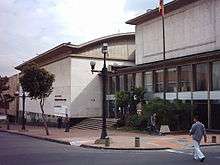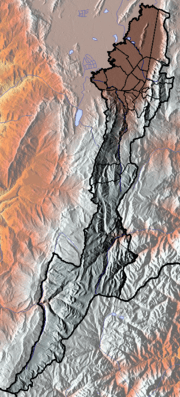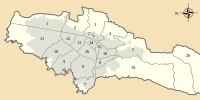La Candelaria
| La Candelaria | |
|---|---|
| Locality of Bogotá | |
|
| |
 Location of the locality in the city of Bogotá | |
 Location of the locality in the Capital District of Bogotá | |
| Coordinates: 4°35′30″N 74°04′27″W / 4.591722°N 74.074130°WCoordinates: 4°35′30″N 74°04′27″W / 4.591722°N 74.074130°W | |
| Country |
|
| City | Bogotá D.C. |
| Area | |
| • Total | 2.06 km2 (0.80 sq mi) |
| Elevation | 2,600 m (8,500 ft) |
| Population (2007)[1] | |
| • Total | 22,115 |
| • Density | 11,000/km2 (28,000/sq mi) |
| Time zone | UTC-5 (Colombia Standard Time) |
| Website | Official website |
La Candelaria is the 17th locality of Bogotá, Colombia. A historic neighborhood in the city's downtown, it is the equivalent to the Old City in other cities.[2] The architecture of the old houses, churches and buildings has Spanish Colonial, Baroque and art deco styles. It houses several universities, libraries and museums.
Attractions
- Calle del Embudo - The narrow, cobblestoned street gets its name from its shape. Embudo translates to "funnel" in English; the street is shaped like a funnel. It is one of the most colourful streets in the historic La Candelaria district and leads to the Plaza del Chorro de Quevedo. Many walls on Calle del Embudo are painted with street art or graffiti, in the bright colours of Colombia. Some of them depict legends from the pre-Columbian era.
- Plaza del Chorro de Quevedo - It is believed that the Spanish conquistador Gonzalo Jiménez de Quesada established the capital city of Bogotá on this square on August 6, 1538. The square takes its name from an Augustinian priest, Friar Quevedo, who in 1832 purchased the site and set up the public water fountain in the centre. Its water supply was cut off when a nearby building collapsed in 1896. It is also believed that it was from this site that the zipa, the main cacique of the Muisca, viewed the Bogotá savanna. Today, with all the buildings that surround the square, no such view is available.
Street of La Candelaria.
Art deco house - La Vieja Suiza, Calle 12 No. 3-07 Bogotá, Colombia

The Luís Ángel Arango Library facade and part of 11th street at La Candelaria neighborhood.
- Botero Museum, located on Carrera 11, contains works by painter/sculptor Fernando Botero as well as works by artists including Monet and Picasso from Botero's private collection.
- Luis Angel Arango Library is the most important library of Colombia, property of the Republic Bank; has more than 1.1 million books and is the most visited public library in Latin America, has facilities of parking, cafeteria, museums, concert hall, and exposition areas. you need coins to leave your bag in the checkroom.
- Gold Museum is one of the most important museums of Colombia, It has a collection of more than 36,000 pieces in gold, wood, shell and stone organized in its three floors; the museum is property of the Republic Bank and is located in front of Santander Park.
- Colón Theater is one of the most representative theatres of Colombia, with a neoclasic architecture, was built by the Italian architect Pietro Cantini, founded in 1892; has more than 2,400 square metres (26,000 sq ft) for 900 people.
- Monserrate is the symbol by excellence of the Colombian capital. The hill is a pilgrim destination, as well as a tourist attraction. In addition to the church, there is a restaurant. Monserrate can be accessed by aerial tramway, a funicular or by climbing, the preferred way of pilgrims. You can see it from nearly every point in Bogota.
- Silva Poetry House
- Bogotá Urban Development Museum
- Military Museum
- Rafael Pombo Poetry House
- Avianca Building
- Camarín del Carmen theater
- Quevedo brook plaza (Plaza del Chorro de Quevedo)
- Bolívar Square
Churches
- Primada Cathedral
- San Francisco Church
- San Agustín Church
- Del Carmen Church
Universities
- University of the Andes
- Our Lady of the Rosary University
- La Salle University
- Universidad Externado de Colombia
- La Gran Colombia University
- Unified National Corporation of Higher Education (CUN)
References
- ↑ (in Spanish) Population 2007 – DANE
- ↑ Kaufman, David. "The Return of Bogotá." TIME. Thursday April 16, 2009. Retrieved on April 22, 2009.
External links
| Wikivoyage has a travel guide for La Candelaria. |
This article is issued from
Wikipedia.
The text is licensed under Creative Commons - Attribution - Sharealike.
Additional terms may apply for the media files.

